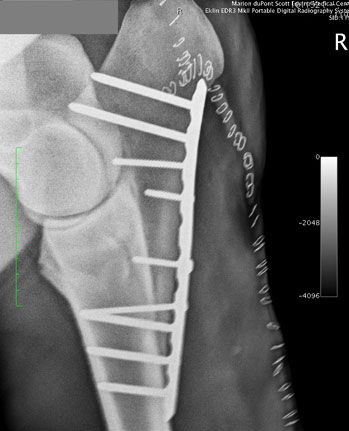Innovative system used at equine medical center to repair fractures

When a human fractures an arm or leg, the results are pain, discomfort, and inconvenience. When a horse fractures a limb, however, the consequences are more serious, possibly even life-threatening.
While the surgical specialists at Virginia Tech’s Marion duPont Scott’s Equine Medical Center have always had the skill and experience to repair many types of equine fractures, they now have an innovative new fixation system — the Locking Compression Plating system — available for those cases where this advanced bone plating system will provide the best treatment option.
The state-of-the-art system is comprised of stainless steel and titanium plates and screws, along with instruments unique to the locking plate technique. It offers advantages over traditional fracture fixation systems, which are also in use at the equine medical center.
Bone plates, which were developed to fix human fractures, have been used for equine fracture repair for nearly 40 years. Over this period of time, bone plates have been improved to provide better compression across the fracture line and better stabilization, which helps speed the healing process. This same technology has helped improve the chances for repair of equine limb fractures.
In order to repair a horse’s broken or weakened bone with the Locking Compression Plating system, a horse undergoes a surgical procedure which involves implanting extremely strong plates that accept two different types of threaded screws. One type of screw, the cortical bone screw, helps compress the fracture line and can be angled relative to the plate. The other type of screw, the locking screw, has special threads in the head that lock right into the plate, unifying the plate/screw unit, which provides a greater level of stability.
Because the Locking Compression Plating system also includes a tool that can contour a plate so that it exactly matches the shape of the bone being repaired, the system provides a support structure that is tailored to the individual horse’s anatomy and needs. After the plate is contoured to the bone, holes are drilled in the bone and the appropriate screws are embedded to attach the plate to the bone.
“The main advantage of the [Locking Compression Plating] system is that it provides a greater degree of stability in the horse’s limb both during and after recovery,” explained Dr. Jennifer Barrett, an assistant professor of surgery at the center. “With greater stability, there is less likelihood of failure, which might lead to a new fracture.” The system also allows for better blood circulation, which helps facilitate healing.
“And, during the healing process, if the fracture repair is more stable, the horse is more comfortable, which can help prevent problems like laminitis in the opposite foot,” Barrett added.
In putting this innovative system to use, surgeons at the EMC have been able to give every advantage to an injured horse. Should a horse suffer a broken leg — depending on the severity of the fracture — it might have to be euthanized. The unique Locking Compression Plating system offers a much greater chance of bringing the horse back to full health and avoiding the loss of the animal.
Recently, Barrett utilized the system on a pregnant thoroughbred broodmare that was brought to the equine medical center with a broken elbow. “Fortunately, we had this state-of-the-art system at our fingertips,” Barrett noted, “and the outcome was very rewarding: she recovered completely and had a beautiful foal.”
The equine medical center was able to purchase the fracture fixation system as a result of annual donations. “Donations to the center allow us to continue to invest in state-of-the-art equipment so that we can maintain our high standard of delivering excellent care to our patients,” said Dr. Nat White, the Jean Ellen Shehan Professor and director of the center. “Each and every year, thousands of our patients benefit from the generosity of our donors.”




